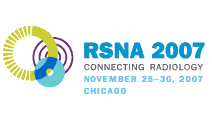
Abstract Archives of the RSNA, 2007
John Allan Bracken MSc, Presenter: Nothing to Disclose
Prasheel Lillaney, Abstract Co-Author: Nothing to Disclose
Rebecca Fahrig PhD, Abstract Co-Author: Research support, Siemens AG
John Alan Rowlands PhD, Abstract Co-Author: Nothing to Disclose
We are developing a hybrid x-ray/magnetic resonance imaging (MRI) system that will simplify percutaneous aortic valve replacement. We hypothesize that treatment availability and safety can be improved for aortic stenosis patients when using this system. The C-arm x-ray system and the MRI scanner will be in close proximity to each other to minimize patient transfer and device dislodgment risks, while image quality of soft tissue, devices, the aorta, and the coronary arteries is maximized.
Anode rotation frequency, anode torque and rotor heating of an x-ray tube are affected by the fringe field of the MRI scanner. A standard rotating anode x-ray tube was placed in the fringe field of a 1.5 T MRI scanner. Anode rotation frequency was measured using a strobe light. Anode torque was measured by placing the tube in an electromagnet and detecting changes in anode rotation frequency using a microphone. Heating of the stalled tube rotor due to eddy currents from a magnetic field was measured using a thermocouple. Magnetic shielding of the rotor due to the presence of the iron stator ring in the tube was measured using a Hall effect sensor.
Anode rotation frequency decreased by 8% in a 30 mT fringe field. The iron stator ring shielded the central 3.5 cm of the rotor up to fields of ≃ 30 mT. Power dissipated in the stalled rotor was ≃ 14 W.
The x-ray tube anode maintained a rotation frequency above 50 Hz in magnetic fields < 30 mT, and maximum track loading power was reduced by only 5% for a single exposure. At larger magnetic field strengths, experimental results show that a stator can be designed such that it covers the entire rotor length to shield it completely from the MRI fringe field. Eddy current heating in the rotor due to MRI fringe fields does not significantly impact tube heat loading. X-ray tubes can be modified to function effectively in this imaging system for aortic valve replacement.
Close-proximity hybrid x-ray/MRI systems will simplify percutaneous aortic valve replacement procedures so that more aortic stenosis patients will be able to receive effective treatment.
Bracken, J,
Lillaney, P,
Fahrig, R,
Rowlands, J,
Hybrid X-ray/Magnetic Resonance Imaging for Percutaneous Aortic Valve Replacement. Radiological Society of North America 2007 Scientific Assembly and Annual Meeting, November 25 - November 30, 2007 ,Chicago IL.
http://archive.rsna.org/2007/5001418.html

